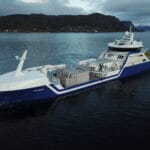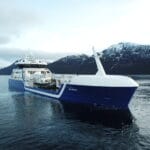News Release
Ro Senja to start work in Norway
March 31, 2023
Yanmar Europe B.V.
The Ro Senja is currently on her way to the northern part of Norway, where she will be doing most of her work for client Salmar. Fully loaded, she weighs about 7,000 tonnes, and while emptied, she can reach a speed of up to 14 knots.

She is a live fish carrier with an emphasis on fish welfare and hygiene. Project manager Mathias Tungevåg at designer Skipskompetanse says,
“Although being quite similar to her sisters Ro Vision and Ro Venture, like them, she is, in fact, unique, being adapted for her client and its operational profile, and new equipment has been installed on board. She is specially designed for delicing operations and aims to achieve the best possible fish welfare.”
Generator power on board comes courtesy of 3 Yanmar 6EY22ALW sets. Tungevåg explains, “Ro Senja and all the other vessels in the LFC2020 range are equipped with a diesel-electric propulsion system. Ro Senja, along with Ro Vision and Ro Venture, also have a battery pack installed for peak shaving and backup. This system allows her to optimise the power generation for her needs in various modes of circulation, manoeuvring and cargo hold operations. Located in the engine room aft, the generator sets supply power to the switchboard, which distributes it to the electric propulsion motors, pumps and other equipment installed on board. They can also charge the battery, which can then be used to supply power during high power peaks for a limited time period, reducing the number of times the generators have to be started to supply sufficient power.”
Selection criteria

Much thought goes into the choice of generator. Tungevåg continues:
“To choose generators, one has to look at the various modes a vessel will operate in. Based on the required power in each of these modes, a setup allowing sufficient power in each mode can be made. The goal would be to have the generators operating at optimum load during all modes. On this kind of vessel with many different modes requiring different amounts of power, the combination of diesel generators with a battery has proven to be a good solution. The generators can mostly run at the most efficient load while the battery handles variable power requests to avoid having to start more generators for small extra power needs.
For us, in cooperation with the owner and yard, durability is key when selecting generators. These live fish carriers operate year-round and need a reliable source of power. So far, Yanmar has proven to be an excellent choice, having been part of over 50 engine installations on vessels designed by Skipskompetanse.”
While diesel has ruled the roost for decades, credible alternatives are now on the horizon. “We’re keeping a close eye on the development of fuel alternatives and engines,” notes Tungevåg. “
So far, it’s hard to pinpoint what will be the future technology, as many parties are eager to prove their ideas. Hydrogen, methanol and other fuels are likely to be part of future ship designs, but these options require access from the shore for effective use. For us, we are focusing on designing vessels like the Ro Senja with an effective hull and power setup. This is currently the most effective way to reduce emissions and costs in the near term while we are looking for the best long-term zero-emissions solution.”
Press Release Download
Inquiries
Yanmar Europe B.V., Marketing Dept.
Dana van Kammen
dana_vankammen@yanmar.com
- Note: Information contained in the news release is valid at the time of publication and may differ from the most recently available information.


